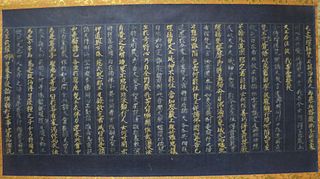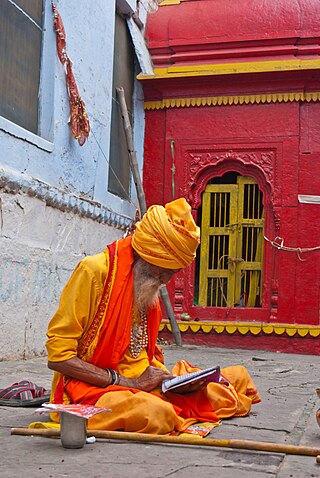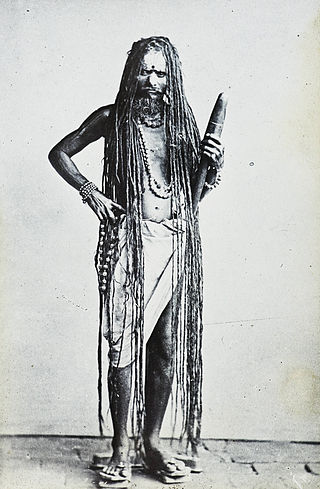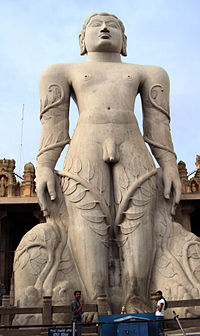
Siddhartha Gautama, most commonly referred to as the Buddha, was a wandering ascetic and religious teacher who lived in South Asia during the 6th or 5th century BCE and founded Buddhism. According to Buddhist legends, he was born in Lumbini, in what is now Nepal, to royal parents of the Shakya clan, but renounced his home life to live as a wandering ascetic. After leading a life of mendicancy, asceticism, and meditation, he attained nirvana at Bodh Gaya in what is now India. The Buddha then wandered through the lower Indo-Gangetic Plain, teaching and building a monastic order. Buddhist tradition holds he died in Kushinagar and reached parinirvana.
Duḥkha (Sanskrit; Pali: dukkha), 'unease', "standing unstable," commonly translated as "suffering", "pain", or "unhappiness", is an important concept in Buddhism, Jainism and Hinduism. Its meaning depends on the context, and may refer more specifically to the "unsatisfactoriness" or "unease" of mundane life, not being at ease when driven by craving/grasping and ignorance.
This is an index page of Wikipedia articles related to the topic of religion.

Sannyasa, sometimes spelled Sanyasa or Sanyasi, is life of renunciation and the fourth stage within the Hindu system of four life stages known as Ashramas, with the first three being Brahmacharya, Grihastha (householder) and Vanaprastha. Sannyasa is traditionally conceptualized for men or women in late years of their life, but young brahmacharis have had the choice to skip the householder and retirement stages, renounce worldly and materialistic pursuits and dedicate their lives to spiritual pursuits.
Karuṇā is generally translated as compassion or mercy and sometimes as self-compassion or spiritual longing. It is a significant spiritual concept in the Indic religions of Hinduism, Buddhism, Sikhism, and Jainism.
Taṇhā is an important concept in Buddhism, referring to "thirst, desire, longing, greed", either physical or mental. It is typically translated as craving, and is of three types: kāma-taṇhā, bhava-taṇhā, and vibhava-taṇhā.
Vīrya is a Buddhist term commonly translated as "energy", "diligence", "enthusiasm", or "effort". It can be defined as an attitude of gladly engaging in wholesome activities, and it functions to cause one to accomplish wholesome or virtuous actions.

In Buddhism, an āgama is a collection of early Buddhist texts.
Upādāna is a Sanskrit and Pali word that means "fuel, material cause, substrate that is the source and means for keeping an active process energized". It is also an important Buddhist concept referring to "attachment, clinging, grasping". It is considered to be the result of taṇhā (craving), and is part of the dukkha doctrine in Buddhism.

A śramaṇa or samaṇa is a person "who labours, toils, or exerts themselves for some higher or religious purpose" or "seeker, one who performs acts of austerity, ascetic".. The Śramaṇa tradition includes primarily Jainism, Buddhism, and others such as the Ājīvika.
Nekkhamma is a Pāli word generally translated as "renunciation" or "the pleasure of renunciation" while also conveying more specifically "giving up the world and leading a holy life" or "freedom from lust, craving and desires." In Buddhism's Noble Eightfold Path, nekkhamma is the first practice associated with "Right Intention." In the Theravada list of ten perfections, nekkhamma is the third practice of "perfection." It involves non-attachment (detachment).

Buddhism and Hinduism have common origins in the culture of Ancient India. Buddhism arose in the Gangetic plains of Eastern India in the 5th century BCE during the Second Urbanisation. Hinduism developed as a fusion or synthesis of practices and ideas from the ancient Vedic religion and elements and deities from other local Indian traditions.

Abhijñā is a Buddhist term generally translated as "direct knowledge", "higher knowledge" or "supernormal knowledge." In Buddhism, such special knowledge is obtained through virtuous living and meditation. The attainment of the four jhanas, or meditative absorptions, is considered a prerequisite for their attainment. In terms of specifically enumerated knowledges, these include mundane extra-sensory abilities as well as the supramundane, meaning the extinction of all mental intoxicants (āsava).

Kaundinya, also known as Ājñātakauṇḍinya, Pali: Añña Koṇḍañña), was one of the first five Buddhist monks (Pancavaggiya), disciple of Gautama Buddha and the first to attain the fruit of Arahant. He lived during the 5th century BCE in what are now Uttar Pradesh and Bihar, India. According to traditional accounts, at the time of Gautama Buddha's birth, he predicted his future destination as an enlightened teacher. Kaundinya Gotra is Hindu Gotra or clan name, named after the rishi Kaundinya.

Adhiṭṭhāna has been translated as "decision," "resolution," "self-determination," "will", "strong determination" and "resolute determination." In the late canonical literature of Theravada Buddhism, adhiṭṭhāna is one of the ten "perfections", exemplified by the bodhisatta's resolve to become fully awakened.
Raga is a Buddhist and Hindu concept of character affliction or poison referring to any form of "greed, sensuality, lust, desire" or "attachment to a sensory object". Raga is represented in the Buddhist artwork as the bird or rooster. In Hinduism, it is one of the five Kleshas or poisons that afflict the soul. In Buddhism, Raga is identified in the following contexts:

The Bhikshuka Upanishad, also known as Bhikshukopanishad, is one of the minor Upanishads of Hinduism and is written in Sanskrit.

The Yajnavalkya Upanishad is a late medieval era Sanskrit text and a minor Upanishad of Hinduism. The text is attached to the Shukla Yajurveda, and is one of the 20 Sannyasa (renunciation) Upanishads.

The Brihat-Sannyasa Upanishad is a 14th- or 15th-century Sanskrit text and one of the minor Upanishads of Hinduism. The text is attached to the Samaveda, and is one of the 20 Sannyasa (renunciation) Upanishads.

The Great Renunciation or Great Departure (mahābhinikmana) is the traditional term for the departure of Gautama Buddha from his palace at Kapilavastu to live a life as an ascetic. It is called the Great Renunciation because it is regarded as a great sacrifice. Most accounts of this event can be found in post-canonical Buddhist texts from several Buddhist traditions, which are the most complete. These are, however, of a more mythological nature than the early texts. They exist in Pāli, Sanskrit and Chinese language.












